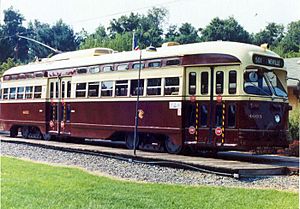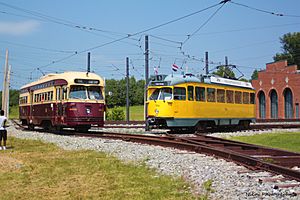National Capital Trolley Museum facts for kids

Toronto PCC streetcar 4603 at the National Capital Trolley Museum's original location in 2002. The museum has since moved to a new facility, roughly in the same area.
|
|
| Lua error in Module:Location_map at line 420: attempt to index field 'wikibase' (a nil value). | |
| Established | 1959 |
|---|---|
| Location | 1313 Bonifant Road, Colesville, Maryland |
| Type | 501(c)(3) nonprofit museum |
| Key holdings | Historic electric street railway vehicles |
| Owner | National Capital Historical Museum of Transportation, Inc. |
The National Capital Trolley Museum (NCTM) is a special place where you can see and ride old electric streetcars, also known as trolleys or trams. It's a nonprofit organization that works to save and share the history of electric streetcars from the Washington, D.C. area and beyond. The museum is located in Montgomery County, Maryland.
Contents
History of the Trolley Museum
The National Capital Trolley Museum started on January 4, 1961. It was first called the National Capital Historical Museum of Transportation, Inc. At first, things moved slowly. Later, the museum joined forces with a group from Baltimore that also collected streetcars.
Finding a Home
The museum first found a home in Lake Roland Park in Baltimore, Maryland. However, neighbors nearby caused some problems. So, in 1966, the groups decided to split their collections. The National Capital Trolley Museum moved to its current spot in Colesville, Maryland. The Baltimore Streetcar Museum was then created to focus on Baltimore's transit history.
The land for the museum in Colesville was given by the Maryland-National Capital Park and Planning Commission. Also, DC Transit let the museum use some trolleys for a very low cost. The museum raised $20,000 to build a special garage for the streetcars, called a car barn. Building started on November 20, 1965.
First Rides and New Buildings
The museum originally wanted to run streetcars owned by DC Transit president O. Roy Chalk. But it wasn't until 1970 that Chalk gave several historic Washington streetcars to the museum. Before that, the museum got a few European trams and a car from Johnstown, Pennsylvania.
The NCTM ran its very first streetcar in October 1969. Since then, the museum has been running streetcars regularly on its one-mile track.
In 2008 and 2009, the museum moved into three new buildings. These included a Visitors Center, a large building to display streetcars (called Street Car Hall), and a building for fixing the streetcars. This move was needed because a new highway, the Intercounty Connector (ICC), was built across the museum's old location. The museum officially reopened on Saturday, January 16, 2010.
Learning at the Museum
The museum offers many fun and educational programs all year long.
School Field Trips
Every spring and fall, the museum welcomes school groups for field trips on Thursdays and Fridays. These trips need to be booked in advance.
Summer Programs
During the summer, from June 15 to August 15, special programs are offered on Thursdays and Fridays. These activities are designed for different age groups.
Supporting the Museum
The museum gets most of its money from people who visit and pay admission fees. It also earns money from its gift shop. Members and friends help the museum by paying dues, giving donations, and volunteering their time. Other groups like the Arts and Humanities Council of Montgomery County also help fund different projects. The State of Maryland, Montgomery County, and private donors helped pay for the museum's big move to its current location.
Trolley Collection
The National Capital Trolley Museum has a large collection of historic streetcars. It has had almost every type of Washington, D.C. streetcar that has been saved.
Washington D.C. Streetcars
Some of the Washington, D.C. streetcars in the collection include:
- DC Transit 0522 and 0509*, which are wooden streetcars from before 1900.
- Washington Railway and Electric Company 650, a streetcar from 1912 with a door in the middle.
- Capital Transit 766, a standard streetcar from 1918 (it's being fixed up to look like Capital Traction Company 27).
- Capital Transit 1053*, the only complete "streamliner" streetcar from before the PCC type.
- DC Transit 1101, which was Washington's very first PCC streetcar.
- Capital Transit 07*, 09, and 026*, which are wooden snow sweepers used to clear snow from the tracks.
- Capital Transit 1430, a PCC car built during World War II.
- Capital Transit 1470, a PCC car built in 1945 (it joined the collection in July 2020).
- Capital Transit 1540, another PCC car built in 1945.
The asterisk (*) next to some numbers means those cars were sadly lost in a fire in 2003.
The NCTM has the biggest collection of Washington, D.C. streetcars in the world. It also has old records, journals, and other items about Washington, D.C. streetcars and Maryland interurban railroads.
Streetcars from Other Places
The museum's collection has also included streetcars from many other cities around the world, such as Berlin, Düsseldorf, Graz, The Hague, Toronto, Vienna, New York City, Philadelphia, Johnstown, Pennsylvania, Brussels, and Blackpool.
Museum Exhibits
The National Capital Trolley Museum has several exciting exhibits for visitors to explore.
The Demonstration Railway
| National Capital Trolley Museum | |
|---|---|
| Technical | |
| Track gauge | 4 ft 8 1⁄2 in (1,435 mm) standard gauge |
| Electrification | 600 Volts DC |
When the museum is open, streetcars leave from the Dispatcher's Desk in the Visitor Center. The Demonstration Railway is the museum's biggest and most popular exhibit. The one-mile track goes past the Street Car Hall and the Maintenance Barn. It then goes down into the woods, past a side track called Dodge siding, along Northwest Branch, and to a loop called Fish Hook loop. Here, the streetcar turns around for the ride back.
Street Cars Go to the Movies
In a small theater, you can watch parts of Harold Lloyd’s old silent films. These movies show how important movies and streetcars were to community life in the early 1900s.
Street Car Communities & Rock Creek Railway Co.
This exhibit shows how streetcars helped local communities grow. It includes a working model of the streetcar line through Chevy Chase, which was one of the first neighborhoods built around a streetcar line. You can see pictures of the power house at the end of the line. There's also a worker coming out of a "plow pit." This is where streetcars traveling between downtown and the suburbs would switch from getting power from an underground system to using an overhead trolley pole. Visitors can even use a real controller handle to start the model streetcar! You can also operate a dynamo to make electricity for the lights in the buildings along the track.
Conduit Hall
In Conduit Hall, you can see an actual piece of track and the metal frame for the underground electrical system that powered some streetcars. There's also a model of a conduit switch. Conduit Hall also displays overhead "trolleys" (the part that touches the overhead wire to get electricity) and a hands-on controller from the early 1900s.
Street Car Hall
Next to Conduit Hall and the Visitor Center is the Street Car Hall. This large building usually has seven or more streetcars on display. Near the cars, there are lighted signs with information about the streetcars and their history. The oldest streetcar in the collection, DC Transit 0522, built in 1898, is displayed here. After each streetcar ride, a museum guide will take passengers into Street Car Hall. They will talk about the history of streetcar development and answer any questions.
Past Incidents
In 1970, a special air-conditioned PCC car, the "Silver Sightseer," was damaged and had to be taken apart. In 1987, cars 1053 and 766 were badly damaged in a crash.
One of the biggest challenges for the museum happened on September 28, 2003. One of the two car barns at the museum's old location caught fire. Eight pieces of equipment were destroyed. This was about half of the museum's working streetcars and one-third of its total collection. Washington cars lost included 0509, 1053, 07, and 026. Streetcars from Johnstown (352), Graz (120), and Vienna (6062 and 7802) were also destroyed. The cause of the fire was not fully known, but investigators said it was an accident. Some of the lost cars, like 1053 and 07, were the only ones of their kind left. Right after the fire, the museum kept operating with its remaining cars. Since the fire, the museum has bought or traded for streetcars from other museums to replace the ones that were lost.
Images for kids









